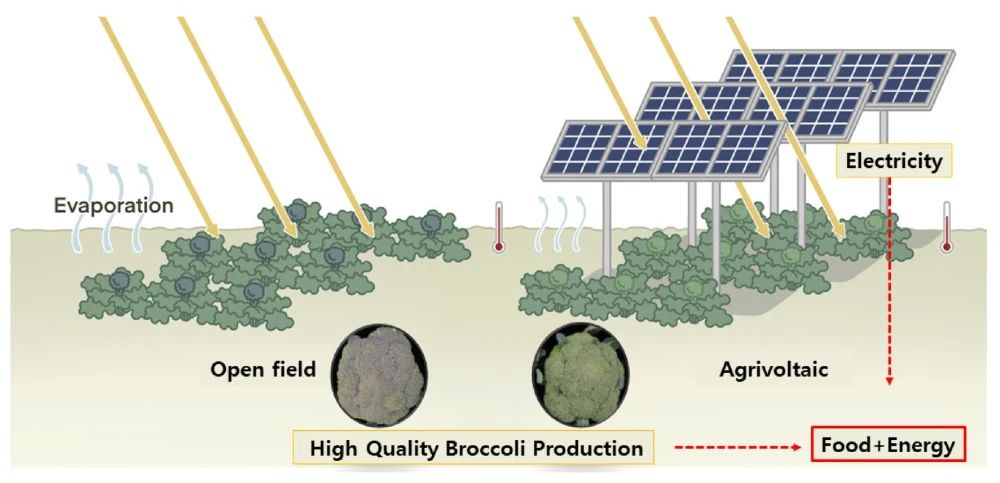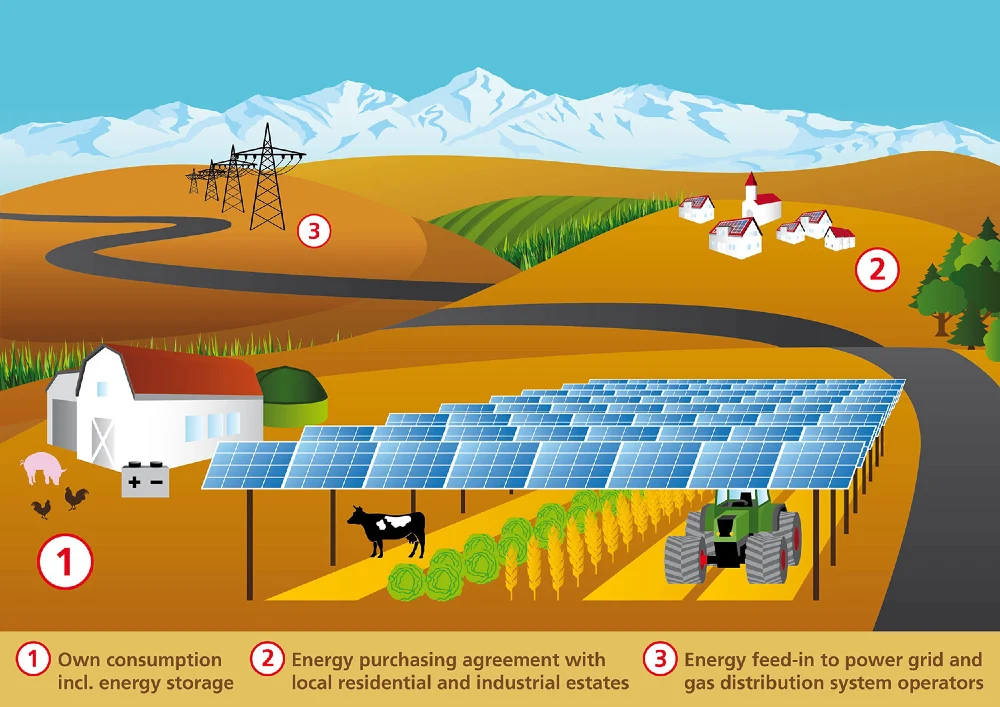With the world population projected to increase by 1.2 billion in the next 15 years, and the escalating demand for resources like water, meat, eggs, dairy, and electricity, finding sustainable solutions is crucial. One innovative approach is agrivoltaics, which marries technology and agriculture to address these challenges. This concept involves integrating solar panel use with farming, a potential solution to the increasing demands on our resources.
Agrivoltaics, or APV, combines agriculture with electricity generation, utilizing the space beneath solar panels for farming. While solar parks aren’t new, their traditional layout poses challenges, such as the underutilization of land beneath the panels and limitations on modern farming equipment due to space constraints. An alternative approach is using solar panels as a canopy over farmland, allowing for dual land use.

Innovative solutions have been proposed to optimize land use for solar energy and agriculture simultaneously. One such solution is using bifacial solar panels, which collect energy from both sides, making them efficient in areas prone to wind erosion and capable of generating more power per square meter. Another design involves mounting panels on stilts, creating space for farming machinery underneath, though this may result in a slight reduction in arable land.
Agrivoltaics not only optimizes land use but also considers the compatibility of certain crops with the shaded environment created by solar panels. Interestingly, not all sunlight is beneficial for plants; beyond a certain threshold, plants need to dispel excess energy, often through water evaporation. Some plants thrive in shaded conditions (shade-tolerant), while others require more sunlight (sun plants) but can also suffer from too much exposure.

Research, such as the RESOLA project in Germany, has shown that in certain conditions, like wet and cold climates, agrivoltaic crops can yield less than traditional farming. However, in dry and hot climates, these crops may outperform those in non-solar fields, indicating that agrivoltaics could be particularly beneficial in hot, arid regions.
Examples of successful agrivoltaics include projects by the Dutch company GroenLeven, which collaborates with local fruit farmers. For instance, a raspberry farm under solar panels in the Netherlands demonstrated equal or better fruit quality compared to traditional methods, with additional benefits like reduced labor for managing protective plastic tunnels and protection from extreme weather.
Agrivoltaics also has a positive effect on solar panels. The limited evaporation from crops under the panels can keep the panels cooler, enhancing their efficiency.

Despite its promise, agrivoltaics faces challenges like community resistance (NIMBY effect), bureaucratic hurdles, and financial viability. The success of agrivoltaics depends on factors like local support, regulations, and the balance between energy production and crop yield. Farmers are more likely to engage in agrivoltaics if the crop yield remains above a certain percentage of traditional methods and if they see operational cost benefits from the solar panels.
In short, agrivoltaics presents an exciting opportunity to address global food and energy challenges simultaneously. It has the potential to reduce greenhouse gas emissions without sacrificing arable land, and if implemented wisely, could transform lands used for biofuel crops into more sustainable food production or even reforestation. The key to its success lies in overcoming logistical, regulatory, and economic challenges, guiding us toward a more sustainable and efficient use of our land resources.
Agrivoltaics From A Farmer’s Perspective
Agrivoltaics, the integration of solar power generation with agriculture, presents a transformative approach for farmers, offering various advantages while also posing certain challenges. Suffice it to say that while on the surface this solution is very appealing, as with any innovation, there are downsides to consider.
Let’s explore the potential impacts, both positive and negative, from a farmer’s perspective.
Advantages for Farmers
- Increased Land Utilization: Agrivoltaics allows farmers to generate electricity while still using the land for agriculture. This dual usage can be particularly beneficial for farmers with limited land, as it maximizes the productivity of their acreage.
- Reduced Water Usage: Studies have shown that the shade provided by solar panels can reduce water evaporation from the soil, leading to a decrease in irrigation needs. This is especially advantageous in arid regions where water conservation is critical.
- Protection for Crops: The solar panels can protect crops from extreme weather conditions, such as hail, heavy rain, or intense sunlight. This can lead to better crop yields and reduced risk of crop failure.
- Additional Income Stream: By generating solar power, farmers can create an additional source of income, either through the use of the electricity on their own farms or by selling excess power back to the grid.
- Sustainable Farming Practices: Agrivoltaics aligns with sustainable farming practices by promoting renewable energy and reducing the carbon footprint associated with traditional farming methods.
- Government Incentives and Subsidies: In some regions, farmers might benefit from government incentives and subsidies for renewable energy, which can help offset the initial costs of setting up solar panels.

It’s all very robust. It is also nice that it feels 10 degrees cooler under the panels during hot periods. That works much better, plus it prevents your raspberries from cooking. And it only needs to be extremely hot for 3 days to lose your harvest. Furthermore, the harvest is comparable to the raspberries grown under foil. The size, taste, and shelf life are pretty much the same. Yes, I’m positive about it so far.
Disadvantages for Farmers
- Initial Investment Costs: The upfront cost of installing solar panels can be significant, which might be a barrier for small-scale farmers or those with limited capital.
- Altered Microclimate: The presence of solar panels can change the microclimate of the area beneath them, potentially affecting the types of crops that can be grown successfully.
- Complexity in Farm Management: Managing an agrivoltaic farm can be more complex than traditional farming. Farmers must consider the placement of solar panels, the types of crops that can grow in shaded conditions, and how to integrate solar maintenance with agricultural activities.
- Limited Equipment Access: In some agrivoltaic setups, the height or arrangement of solar panels may restrict the use of large farming machinery, potentially complicating farming processes.
- Training and Knowledge: Farmers may need additional training and knowledge in solar energy management, which could be a challenge for those not familiar with these technologies.
And, of course, there’s always the fact that solar panels have a limited lifespan and must be replaced in time, causing considerable waste to end up in our landfills.
Agrivoltaics presents a compelling case for farmers, offering a blend of economic, environmental, and agricultural benefits.
More To Discover
- Permaculture Explained: Everything You Need to Know
- MIT’s Bacteria-Based Solution for Sustainable Farming May, One Day, Replace Chemical Fertilizers
- Panasonic’s Innovative Semi-Transparent Perovskite Solar Panels Look Like Windows or Walls
- World’s First Silicon-Free Solar Panel Is Hair-Thin and Transparent
While the initial costs and complexity of management pose challenges, the long-term gains in terms of additional income, improved sustainability, and environmental conservation make it an attractive proposition.
For the agriculture sector as a whole, embracing agrivoltaics could be a significant step towards a more sustainable and resilient future.




















